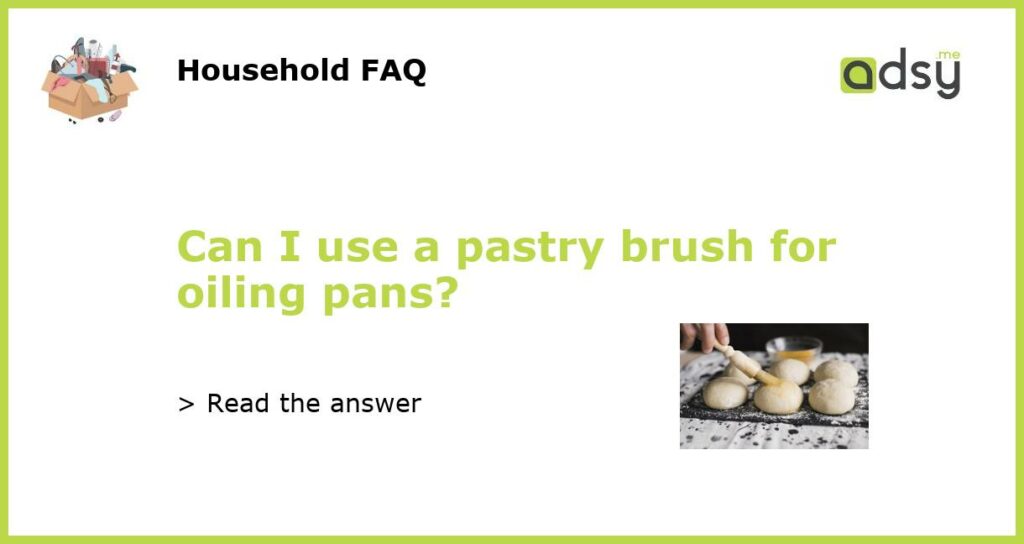Yes, you can use a pastry brush for oiling pans
A pastry brush is a versatile kitchen tool often used for brushing egg wash or glazes onto pastries, but it can also be used for other cooking and baking tasks. When it comes to oiling pans, a pastry brush can be a convenient and efficient tool for evenly distributing oil and ensuring that your food doesn’t stick to the pan.
The benefits of using a pastry brush for oiling pans
Using a pastry brush for oiling pans offers several benefits:
- Control over oil distribution: A pastry brush allows you to have precise control over how much oil you apply to the pan, helping to prevent excess oil from pooling and making your food greasy.
- Even coating: The bristles of a pastry brush can help you evenly distribute the oil across the surface of the pan, ensuring that your food cooks evenly and doesn’t stick.
- Less waste: Using a pastry brush can help you use less oil compared to pouring it directly into the pan, reducing waste and making your cooking more economical.
- Easy to clean: Pastry brushes are typically easy to clean, especially if you choose one with removable and dishwasher-safe bristles. This makes them a convenient tool for everyday cooking and baking.
Tips for using a pastry brush for oiling pans
Here are some tips to get the best results when using a pastry brush for oiling pans:
- Choose the right brush: Look for a pastry brush with natural bristles or silicone bristles, as they are more durable and easier to clean. Avoid using brushes with synthetic bristles, as they may melt or shed when exposed to high heat.
- Apply a thin, even layer: Dip the pastry brush into the oil and lightly coat the surface of the pan, making sure to cover all the corners and edges. Avoid applying too much oil, as it can cause your food to become greasy.
- Brush before preheating: It’s best to brush the oil onto the pan before preheating it. This allows the oil to spread evenly across the surface and helps prevent the oil from smoking or burning.
- Reapply if necessary: If you’re cooking for an extended period or flipping food, you may need to reapply oil to the pan. Check the pan periodically and use the pastry brush to add more oil as needed.
- Clean the brush thoroughly: After using the pastry brush, clean it thoroughly with warm, soapy water or place it in the dishwasher if it’s dishwasher-safe. This helps remove any residual oil and prevents cross-contamination of flavors.
Other uses for a pastry brush
A pastry brush can be a handy tool beyond just oiling pans. Here are some other common uses for a pastry brush in the kitchen:
- Applying glazes and washes: As mentioned earlier, a pastry brush is great for applying glazes, egg washes, or melted butter to pastries, bread, or other baked goods, giving them a beautiful and shiny appearance.
- Basting meat: For roasts or grilled meats, a pastry brush can be used to baste them with flavorful marinades or sauces, adding extra moisture and enhancing the taste.
- Removing excess flour: Use a pastry brush to gently remove any excess flour from dough or work surfaces, ensuring a cleaner and more professional-looking final product.
- Cleaning vegetables: A pastry brush can be used to clean dirt or debris off fruits and vegetables before cooking or eating them, especially if you prefer not to rinse them under water.
- Spreading butter or sauce: Whether you’re making pancakes, grilled cheese sandwiches, or simply buttering bread, a pastry brush can be a neat and efficient way to spread melted butter, sauce, or other spreads evenly.
Yes, you can definitely use a pastry brush for oiling pans. It offers several benefits, including control over oil distribution, even coating, less waste, and easy cleaning. Additionally, a pastry brush can be used for a variety of other kitchen tasks, making it a versatile tool to have in your culinary arsenal.






